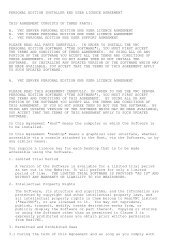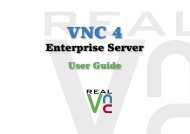VNC User Guide - RealVNC
VNC User Guide - RealVNC
VNC User Guide - RealVNC
You also want an ePaper? Increase the reach of your titles
YUMPU automatically turns print PDFs into web optimized ePapers that Google loves.
Chapter 7: Making Connections Secure<br />
Bypassing the authentication rules<br />
You can enable particular users to connect to <strong>VNC</strong> Server without specifying a password, bypassing <strong>VNC</strong><br />
Server’s authentication mechanism altogether.<br />
Note: You can turn authentication off for all users if you consider it safe to do so. For more information, see<br />
Turning authentication off on page 106.<br />
You can either:<br />
• Establish a reverse connection to a particular client computer. See Establishing a reverse connection on<br />
page 107.<br />
• Allow a particular user to connect as a Guest. See Allowing a Guest to connect on page 108. Note this<br />
remote control feature is not available in <strong>VNC</strong> Server (Free).<br />
Clearly, you should only establish reverse connections to client computers with trustworthy potential users,<br />
and only allow trustworthy users to connect as Guests. If you are setting up <strong>VNC</strong> Server on your own<br />
computer for remote access, note that a user must be present at the host computer for either of these<br />
features to work.<br />
Establishing a reverse connection<br />
You may be able to establish a reverse connection to a particular client computer, bypassing the<br />
authentication mechanism specified by <strong>VNC</strong> Server.<br />
Note: The client computer must be running Listening <strong>VNC</strong> Viewer. For more information, see Starting<br />
Listening <strong>VNC</strong> Viewer on page 34.<br />
Note this feature is also useful if the host computer is protected by a firewall that cannot be configured to<br />
allow network communications, or by a router that cannot be configured to forward network<br />
communications, thus preventing incoming connections. In a reverse connection, network communications<br />
from the host computer are outgoing.<br />
To establish a reverse connection:<br />
1. Open the <strong>VNC</strong> Server shortcut menu. More on this menu.<br />
2. Select Connect to Listening <strong>VNC</strong> Viewer:<br />
3. If you are connecting:<br />
— Within a private network, enter the network address of the client computer itself. If you do not know<br />
what this is, ask a client computer user to run a command such as ipconfig (Windows) or<br />
ifconfig (Linux and Mac OS X).<br />
<strong>VNC</strong> <strong>User</strong> <strong>Guide</strong> 107
















